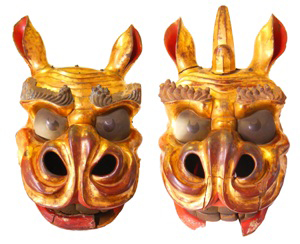About
History
Hiroshima Toshogu is a shrine dedicated to Tokugawa Ieyasu as its enshrined deity. It was constructed in 1648, the 33rd anniversary of the death of Ieyasu, by Asano Mitsuakira (4th generation head of the Asano Clan), who was then lord of the Hiroshima Domain, at the foot of Mt. Futaba in the direction of Hiroshima Castle's "Kimon" (the "devil's gate" located in the northeast of the castle). Since Mitsuakira's birth mother was Princess Furi-hime, the third daughter of Ieyasu, the shrine to Ieyasu was dedicated to his divine spirit both as a means of Mitsuakira honoring and admiring the virtue of his grandfather, and as a supplication for peace in the castle town. Successive lords of the domain were given 300 koku (a traditional Japanese unit of dry measurement, used to measure rice and which was used to evaluate the standing of a feudal domain and its lord) of the shrine land, and the shrine became revered throughout Hiroshima and the surrounding areas. In addition to spring and autumn festivals, the shrine also held a grand festival every 50 years since 1666, which was the 50th anniversary of Ieyasu's death. The shrine pavilions were said to have "the most beautiful view from its location at the foot of Mt. Futaba since the construction of Hiroshima Castle by the Mori Clan", however the explosion of hot air resulting from the dropping of the atomic bomb (the shrine was approximately 2,200 m from the hypocenter on August 6, 1945 caused the destruction of the cypress bark roof "Honden" (main hall) , the "chumon" central gate, the "mizugaki" inner fence, "Haiden" (hall of worship). The present-day shrine buildings were reconstructed in April 1965, the 350th anniversary of Ieyasu's death.

Row of cherry trees(around 1920~1940)
Cultural Properties
The "karamon" gate, "yokuro" transept, "temizusha" purification basin, "Honjido" hall, "Gokusho" (daily offering hall), "wakimon" side gate, mikoshi (portable shrine), and "kirinjishi" (Kirin is a mythological Japanese creature) heads are Hiroshima City Designated Tangible Cultural Properties. These have existed since the construction of the shrine, and are of great historical cultural value for Hiroshima.

"kirinjishi" (Kirin is a mythological Japanese creature) heads
Goshintoku (Divine Virtues)
Ieyasu was born on December 26, 1542 in Okazaki Castle, Mikawa Province. At that time, Japan was in the midst of what was called the "Sengoku Jidai" (Warring States Period), which was a war-torn period, and Ieyasu had a very difficult early life, being taken as a hostage while he was very young. However, he endured the hardships he suffered and persevered, biding his time, for the right moment to create new order from the chaotic society, to promote learning, develop industry, and work towards stabilizing the lives of his country people, and later established a brilliant culture which lasted for over 260 years during the Edo Period, and laid the foundations for peace, greatly contributing to the development of modern Japan. In recent years, his deeds have also come to be highly acclaimed outside of Japan as well. Ieyasu died at the age of 75 at Sumpu Castle on April 17, 1616 and was deified and given the posthumous name "Tosho Daigongen" by imperial decree of the imperial court. It is said that his posthumous teachings were the result of his life experiences, the secret to Ieyasu's success, and are of even greater significance today.
Posthumous Teachings
A person's life is like a heavy burden carried on a long road, one should not rush through If you treat inconvenience as normal, you will have no shortage of it, and when your heart fills with hope, you should remember the difficult times Patience is the basis of safety and longevity, and anger is the enemy Knowing only how to win and not knowing how to lose will cause you damage Do not condemn others for your own faults, less is better than more
